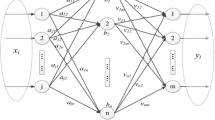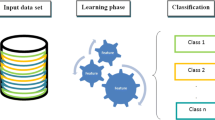Abstract
Extreme learning machine (ELM) not only is an effective classifier in supervised learning, but also can be applied on unsupervised learning and semi-supervised learning. The model structure of unsupervised extreme learning machine (US-ELM) and semi-supervised extreme learning machine (SS-ELM) are same as ELM, the difference between them is the cost function. We introduce kernel function to US-ELM and propose unsupervised extreme learning machine with kernel (US-KELM). And SS-KELM has been proposed. Wavelet analysis has the characteristics of multivariate interpolation and sparse change, and Wavelet kernel functions have been widely used in support vector machine. Therefore, to realize a combination of the wavelet kernel function, US-ELM, and SS-ELM, unsupervised extreme learning machine with wavelet kernel function (US-WKELM) and semi-supervised extreme learning machine with wavelet kernel function (SS-WKELM) are proposed in this paper. The experimental results show the feasibility and validity of US-WKELM and SS-WKELM in clustering and classification.

Similar content being viewed by others
References
Huang GB, Zhu QY, Siew CK (2006) Extreme learning machine: theory and applications. Neurocomputing 70(1):489–501
Cao JW, Lin ZP (2015) Extreme learning machines on high dimensional and large data applications: a survey. Math Probl Eng 2015:1–12
Ding SF, Xu XZ, Nie R (2014) Extreme learning machine and its applications. Neural Comput Appl 25(3):549–556
Liu HP, Sun FC, Yu YL (2014) Multitask extreme learning machine for visual tracking. Cogn Comput 6(3):391–404
Deng WY, Zheng QH, Chen L, Xu XB (2010) Research on extreme learning of neural networks. Chin J Comput 33(2):279–287
Zhang N, Ding SF, Zhang J (2016) Multi layer ELM-RBF for multi-label learning. Appl Soft Comput 43:535–545
Zong WW, Huang GB, Chen YQ (2013) Weighted extreme learning machine for imbalance learning. Neurocomputing 101:229–242
Bai Z, Huang GB, Wang D, Westover MB (2014) Sparse extreme learning machine for classification. IEEE Trans Cybern 44(10):1858–1870
He Q, Jin X, Du CY, Zhuang FZ, Shi ZZ (2014) Clustering in extreme learning machine feature space. Neurocomputing 128:88–95
Huang G, Song SJ, Gupta JND, Wu C (2014) Semi-supervised and unsupervised extreme learning machines. IEEE Trans Cybern 44(12):2405–17
Zheng YH, Jeon B, Xu DH, Jonathan Q, Wu M, Zhang H (2015) Image segmentation by generalized hierarchical fuzzy C-means algorithm. J Intell Fuzzy Syst 28(2):961–973
Defays D (1977) An efficient algorithm for a complete link method. Comput J 20(4):364–366
Ester M, Kriegel HP, Sander J, Xu X (1996) A density-based algorithm for discovering clusters in large spatial databases with noise. In: Proceedings of 2nd International Conference on KDD. AAAI Press, Menlo Park, pp 226–231
Von Luxburg U (2007) A tutorial on spectral clustering. Stat Comput 17(4):395–416
Tison C, Nicolas JM, Tupin F, Maître H (2004) A new statistical model for Markovian classification of urban areas in high-resolution SAR images. IEEE Trans Geosci Remote Sens 42(10):2046–2057
Blum A, Mitchell T (1998) Combining labeled and unlabeled data with co-training. In: Proceedings of the Eleventh Annual Conference on Computational Learning Theory. ACM Press, New York, pp 92–100
Belkin M, Niyogi P, Sindhwani V (2006) Manifold regularization: a geometric framework for learning from labeled and unlabeled examples. J Mach Learn Res 7:2399–2434
Liu SL, Feng L, Xiao Y, Wang HB (2014) Robust activation function and its application: semi-supervised kernel extreme learning method. Neurocomputing 144:318–328
Zhang L, Zhou WD, Jiao LC (2004) Wavelet support vector machine. IEEE Trans Syst Man Cybern Part B Cybern 34(1):34–39
Ding SF, Wu FL, Shi ZZ (2014) Wavelet twin support vector machine. Neural Comput Appl 25(6):1241–1247
Filannino M, Liu Z, Cuturi M (2007) UCI Machine Learning Repository. http://archive.ics.uci.edu/ml/
Lee KC, Ho J, Kriegman D (2005) Acquiring linear subspaces for face recognition under variable lighting. IEEE Trans Pattern Anal Mach Intell 27(5):684–698
Samaria FS, Harter AC (1994) Parameterisation of a stochastic model for human face identification. In: Proceedings of the Second IEEE Workshop on Applications of Computer Vision. IEEE Press, New York, pp 138–142
Papadimitriou CH, Steiglitz K (1998) Combinatorial optimization: algorithms and complexity. Courier Dover Publications, Mineola
Graham DB, Allinson NM (1998) Characterizing virtual eigensignatures for general purpose face recognition. In: Wechsler H, Phillips PJ, Bruce V, Fogelman-Soulie F, Huang TS (eds) Face recognition: from theory to applications. NATO ASI Series F, Computer and Systems Sciences, vol 163, pp 446–456
Acknowledgments
This work is supported by the National Natural Science Foundation of China (No.61379101).
Author information
Authors and Affiliations
Corresponding author
Rights and permissions
About this article
Cite this article
Zhang, N., Ding, S. Unsupervised and semi-supervised extreme learning machine with wavelet kernel for high dimensional data. Memetic Comp. 9, 129–139 (2017). https://doi.org/10.1007/s12293-016-0198-x
Received:
Accepted:
Published:
Issue Date:
DOI: https://doi.org/10.1007/s12293-016-0198-x




